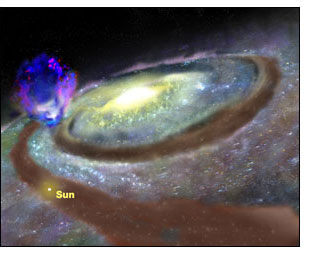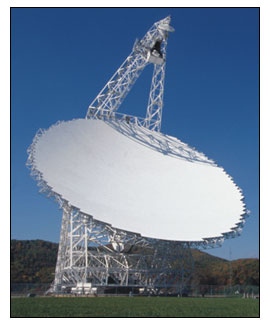GREEN BANK, W.V., Jan. 19, 2006 -- Astronomers using the National Science Foundation's Robert C. Byrd Green Bank Telescope (GBT) recently made three discoveries: a huge "superbubble" of hydrogen gas in the Milky Way, the fastest-spinning pulsar ever observed and a coiled magnetic field that resembles the children's toy, the Slinky.

An artist's rendition of a superbubble rising above the Milky Way's plane. (Illustration: Bill Saxton, NRAO/AUI/NSF)
Rising nearly 10,000 light-years above the plane of Earth's Milky Way Galaxy, the astronomers believe the superbubble of gas may be driven by violent supernova explosions and the intense stellar winds from an unseen cluster of young stars in one of the galaxy's spiral arms.
"This giant gas bubble contains about a million times more mass than the sun and the energy powering its outflow is equal to about 100 supernova explosions," said Yurii Pidopryhora, of the National Radio Astronomy Observatory (NRAO) and Ohio University. Pidopryhora, along with Jay Lockman of NRAO and Joseph Shields of Ohio University, presented their results to the American Astronomical Society's meeting in Washington earlier this month.
The giant radio telescope also enabled astronomers to spot the pulsar in a globular cluster of stars called Terzan 5 in the constellation Sagittarius, about 28,000 light-years from Earth. Pulsars, the remnants of massive stars that exploded, are spinning neutron stars that sling beams of radio waves or light around as they spin. The pulsar discovered with the GBT spins 716 times per second and is estimated to be no more than 20 miles in diameter. Astronomers have found 33 other fast-spinning pulsars in the same star cluster, while the Slinky-shaped magnetic field was found wrapped around a gas cloud in the constellation Orion.
The superbubble is nearly 23,000 light-years from Earth. The astronomers discovered it by combining numerous smaller images made with the GBT into one large image. In addition, they added images of ionized hydrogen in the region that were made by a University of Wisconsin optical telescope on Kitt Peak in Arizona.
"We see that all the hydrogen gas in this region of the galaxy is disturbed, with many smaller outflows closer to the plane of the galaxy and then a giant plume of gas that forms a sort of cap on the whole thing," Pidopryhora said. The ionized hydrogen, with atoms violently stripped of their electrons, seems to fill the interior of the superbubble while the neutral hydrogen forms its walls and cap.
The Milky Way Galaxy, about 100,000 light-years across, somewhat resembles a giant dinner plate, with most of its stars and gas residing in a flat disk. "Gas driven outward from the plane of the galaxy's disk has been seen many times before, but this superbubble is particularly large," Lockman said. "The eruption that drove this much mass so far out of the plane has to have been unusually violent," he added.
The scientists speculate that the gas may be blown outward by the strong stellar winds and supernova explosions from numerous massive young stars in a cluster. "One theoretical model shows that young stars could power an outflow that matches what we see very closely," Pidopryhora said. According to that model, the superbubble probably is 10-30 million years old.

The Robert C. Byrd Green Bank Telescope (Photo: NRAO/AUI/NSF)
"Finding this superbubble practically in our back yard is quite exciting, because these superbubbles are very important factors in how galaxies evolve," Lockman said.
Powered by supernova explosions and young stellar winds, superbubbles control the way heavy elements, produced only in the cores of stars, are distributed throughout the galaxy, the scientists said. Those heavy elements are then incorporated into the next generation of stars -- and planets -- to form. "The formation of our own sun and planets probably was heavily influenced, if not triggered, by a nearby supernova explosion," Lockman said.
In addition, if the outflow from superbubbles is energetic enough, it could blow the gas into intergalactic space, never to return to the galaxy. "This would shut down the formation of new stars in the galaxy," Pidopryhora explained.
The GBT, dedicated in 2000, is the largest fully-steerable radio telescope in the world, with more than two acres of collecting area in its giant dish. Located within the National Radio Quiet Zone in West Virginia, the GBT provides extraordinary sensitivity for observing faint radio-emitting objects in the distant universe. For more information, visit: www.nrao.edu